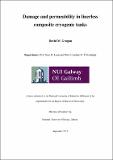| dc.description.abstract | Carbon fibre reinforced polymers (CFRP) are one of the prospective material families being investigated for use in the fuel tanks of future reusable launch vehicles (RLVs). The extreme cryogenic thermo-mechanical loading that these structures experience can lead to damage build-up in the CFRP in the form of microcracking and delamination, which can lead to increased laminate permeability. This work presents a combined experimental and numerical approach for predicting damage and permeability in composite laminates and linerless cryogenic tanks.
A novel extended finite element (XFEM)-based methodology for the combined simulation and prediction of thermal fatigue delamination for identification of delaminated crack opening displacement (DCOD) and, hence, composite laminate permeability is presented first. The methodology is validated through simulation of standardised static and fatigue delamination test methods, using computationally efficient modelling techniques. Delamination growth in a quasi-isotropic laminate under cryogenic fatigue loading is used to examine the effects of initial interlaminar defects on subsequent crack growth, as well as the relationship between delamination length and material permeability based on DCOD values predicted by the new methodology.
An experimental investigation into damage formation in CF /PEEK laminates before, during and after cryogenic cycling, using optical microscopy and three-dimensional X-ray computed tomography (CT), is conducted. Thicker laminates were found to exhibit significantly greater microcrack density and delamination when compared to thinner laminates, with lay-up and material type also being important contributing factors. Microcracking induced by thermal residual stresses was also observed in thicker laminates following processing. 3-D rendering software was used to establish the presence of through thickness crack networks within the laminates, as well as the extent of cracking through the specimen width. Crack opening in inner and off-axis ply groups was found to be significantly less than in outer plies, indicating the importance of these plies for limiting laminate permeability. The presence of voids was found to influence crack nucleation and growth paths within the laminates, with full void volume characterisation presented.
A novel computational methodology for predicting three-dimensional microcracking and permeability in composite laminates is presented based on experimental observations and established numerical methods. The methodology simulates (i) microcrack initiation and propagation using XFEM, and (ii) delamination, using a mixed-mode cohesive zone model. Random microcrack initiation is modelled using a random (Weibull) distribution of fracture strengths. The Weibull distribution is adjusted to account for specimen volume, allowing mesh independent crack density predictions. An alternative method is also investigated, based on an elemental representation of defects using measured void geometry. The predicted microcracking and damage distributions are shown to correlate closely with 3-D X-ray CT scans of cryogenically cycled specimens. Crack opening displacements are consistent with laminate test measurements. Permeabilities, based on the dimensions of the leak paths, were found to be within the measured range for various CF/PEEK materials.
Finally, a combined experimental and numerical approach to the design and analysis of tape-laid composite cryogenic tanks is presented. A detailed material and defect characterisation of automated tape-laid CF/PEEK was undertaken using optical micrography and 3-D X-ray CT, as well as cryogenic testing to investigate damage formation. Resulting material data is used as input to a novel XFEM-cohesive zone methodology which is used to predict intra- and inter-ply damage in an internally pressurised cryogenic tank. An optimised tank lay-up is presented and tested using the numerical method to ensure resistance to microcrack formation and fuel leakage through the tanks walls under operating loads. | en_US |


